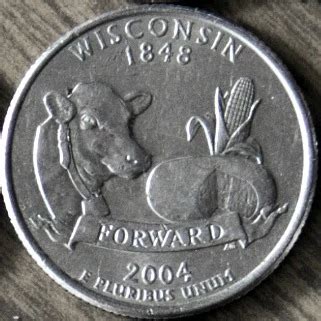
A rare 2004 Wisconsin state quarter featuring an error in the corn stalk design could fetch up to $2,000, prompting coin collectors and casual spenders alike to scrutinize their pocket change. The U.S. Mint released five different quarter designs each year from 1999 to 2008 as part of the 50 State Quarters Program, but the Wisconsin quarter, specifically those with extra leaves on the corn stalk, has become a sought-after collectible.
The 2004 Wisconsin quarter, intended to honor the state’s rich agricultural heritage, came with an unexpected variation that has significantly increased its value. Two versions of the error exist: one with an extra leaf pointing upwards (“extra leaf high”) and another with an extra leaf pointing downwards (“extra leaf low”). These errors are the result of a die gouge, a scratch or indentation on the die used to strike the coins, which then imprinted the extra leaf detail onto the minted quarters.
According to numismatic experts, the value of these error coins varies based on their condition. Uncirculated examples, those that have never been used in circulation and retain their original mint luster, command the highest prices, potentially reaching the reported $2,000 mark. Coins in circulated condition, showing signs of wear and tear, are still valuable but typically fetch prices ranging from $100 to $300, depending on the degree of wear and the specific error type.
The discovery of the error initially spurred a wave of public interest, as individuals across the country began meticulously examining their quarters. Coin collecting, often viewed as a niche hobby, experienced a surge in popularity, with seasoned collectors and newcomers alike eager to find their own potentially valuable Wisconsin quarter.
The rarity of the error lies in the limited number of affected coins that entered circulation. While the U.S. Mint produced hundreds of millions of Wisconsin quarters, only a fraction exhibited the extra leaf error. This limited supply, coupled with strong demand from collectors, has driven the prices of these error coins to remarkable levels.
To identify the error, individuals should carefully examine the corn stalk on the reverse side of the 2004 Wisconsin quarter. The presence of an extra leaf, either pointing upwards or downwards, is the key indicator of the valuable variety. Online resources, coin collecting guides, and professional numismatists can further assist in verifying the authenticity and condition of the coin.
The U.S. Mint’s 50 State Quarters Program, launched in 1999, aimed to commemorate each of the 50 states with unique designs on the reverse of the quarter. The program proved immensely popular, capturing the public’s imagination and sparking renewed interest in coin collecting. The Wisconsin quarter, with its distinctive error, has become one of the most notable and sought-after coins from the entire series.
The tale of the 2004 Wisconsin quarter serves as a reminder that even seemingly ordinary objects can possess extraordinary value. For those willing to invest the time and effort to search, a potentially valuable treasure may be lurking in their pocket change. “Check your pockets, you could have money hiding in plain sight,” according to recent reports highlighting the coin’s potential value. The current interest serves as a microcosm of the larger world of numismatics, where historical significance, rarity, and condition converge to determine the worth of a coin. The 2004 Wisconsin quarter with the extra leaf error is more than just 25 cents; it’s a piece of numismatic history with a compelling story.
Detailed Breakdown and Context
The Wisconsin Quarter and the 50 State Quarters Program
The 50 State Quarters Program was a wildly successful initiative by the U.S. Mint to commemorate each of the United States with a unique quarter design. From 1999 to 2008, five new quarter designs were released each year, in the order that the states ratified the Constitution or were admitted into the Union. The program was designed to educate citizens about the history and geography of the states, as well as to promote coin collecting.
The Wisconsin quarter, released in 2004, features a design intended to represent the state’s agricultural heritage. The design includes a cow, a wheel of cheese, and an ear of corn. However, it was the corn stalk design that led to the creation of valuable error coins. A die gouge, which is essentially a scratch or indentation on the die used to strike the coins, resulted in some quarters being minted with an extra leaf on the corn stalk. These quarters are now highly sought after by collectors.
The Two Varieties of the Error Coin
There are two distinct versions of the 2004 Wisconsin quarter error coin:
-
Extra Leaf High: In this version, the extra leaf appears to be pointing upwards from the corn stalk. This is considered to be one of the variations.
-
Extra Leaf Low: In this version, the extra leaf points downwards from the corn stalk. This is the other variation of the coin.
Identifying which variation one possesses is essential, as both can fetch significant premiums, although the “Extra Leaf High” may sometimes be considered slightly more valuable due to perceived rarity in some markets.
Factors Determining Value
The value of a 2004 Wisconsin quarter with the extra leaf error is primarily determined by the following factors:
-
Condition: The condition of the coin is paramount in determining its value. Coins are graded on a scale ranging from Poor (PR) to Mint State (MS). Uncirculated coins (MS60 and above) are the most valuable because they have never been used in circulation and retain their original mint luster. Circulated coins, which show signs of wear, are less valuable. The Sheldon Scale is often used to determine the grade, and the higher the grade, the more the coin is worth.
-
Rarity: While millions of Wisconsin quarters were minted, only a small fraction have the extra leaf error. The relative scarcity of these error coins compared to the total number of Wisconsin quarters minted drives up their value. The exact mintage figures for the error coins are unknown, which adds to their mystique and value.
-
Demand: The demand for the coin among collectors also plays a significant role in determining its price. If there is a high demand for the coin and a limited supply, prices will increase. The publicity surrounding the 2004 Wisconsin quarter error has undoubtedly increased demand, further driving up prices.
-
Certification: Having the coin professionally graded and certified by a reputable grading service such as the Professional Coin Grading Service (PCGS) or the Numismatic Guaranty Corporation (NGC) can significantly increase its value. Certification ensures the coin is authentic and accurately graded, providing buyers with confidence.
How to Identify the Error
To identify a 2004 Wisconsin quarter with the extra leaf error, follow these steps:
- Check the Date: Ensure the quarter is from 2004. The error only occurs on quarters minted in this year.
- Locate the Corn Stalk: On the reverse side of the coin, find the image of the corn stalk.
- Examine the Leaves: Carefully examine the leaves on the corn stalk. Look for an extra leaf either pointing upwards or downwards. This extra leaf will appear as a distinct protrusion from the stalk.
- Use Magnification: A magnifying glass can be helpful in identifying the extra leaf, especially on coins that are circulated and may have wear.
- Compare with Images: Compare the coin with known images of the error coin. Numerous resources online provide clear pictures of both the “extra leaf high” and “extra leaf low” varieties.
The Role of Coin Grading Services
Professional coin grading services like PCGS and NGC play a crucial role in the numismatic world. These services evaluate coins based on their condition, authenticity, and other factors, assigning a grade that reflects their overall quality. Coins that are graded and certified by these services are often more valuable because they offer buyers assurance of their authenticity and condition.
- PCGS (Professional Coin Grading Service): PCGS is one of the most respected and widely recognized coin grading services in the world. They provide a guarantee of authenticity and grade accuracy.
- NGC (Numismatic Guaranty Corporation): NGC is another leading coin grading service that is highly regarded by collectors. Like PCGS, they offer a guarantee of authenticity and grade accuracy.
The process of submitting a coin for grading involves sending the coin to the grading service, where it is examined by experts. The coin is then assigned a grade based on the Sheldon Scale, which ranges from 1 to 70. The higher the grade, the better the condition of the coin and the more valuable it is likely to be. The coin is then encapsulated in a tamper-evident holder, which protects it from damage and ensures its authenticity.
Impact on Coin Collecting
The discovery of the 2004 Wisconsin quarter error has had a significant impact on the hobby of coin collecting. It has brought renewed attention to the 50 State Quarters Program and has encouraged more people to take an interest in numismatics. The story of a seemingly ordinary quarter being worth thousands of dollars is appealing and has captured the imagination of the public.
The increased interest in coin collecting has led to a surge in demand for coin collecting supplies, such as albums, magnifying glasses, and reference books. It has also led to more people attending coin shows and joining coin collecting clubs. The 2004 Wisconsin quarter error has shown that there is still the potential to find valuable coins in circulation, which has motivated people to search through their pocket change.
The Broader Numismatic Landscape
The 2004 Wisconsin quarter error is just one example of the many rare and valuable coins that exist in the world. The field of numismatics is vast and complex, with a wide range of factors influencing the value of a coin. These factors include:
- Rarity: The fewer the number of a particular coin that were minted, the more valuable it is likely to be.
- Condition: The better the condition of the coin, the more valuable it is likely to be.
- Historical Significance: Coins that are associated with important historical events or figures are often more valuable.
- Metal Content: Coins made of precious metals, such as gold or silver, are often more valuable.
- Errors and Varieties: Coins with errors or varieties, such as the 2004 Wisconsin quarter with the extra leaf, are often highly sought after by collectors.
Some of the most valuable coins in the world include the 1794 Flowing Hair Silver Dollar, the 1804 Draped Bust Silver Dollar (known as the “King of American Coins”), and the 1933 Double Eagle Gold Coin. These coins have sold for millions of dollars at auction.
The Psychology of Coin Collecting
Coin collecting is more than just a hobby; it is a pursuit that taps into several fundamental aspects of human psychology. Collectors are driven by a variety of motivations, including:
- The Thrill of the Hunt: The excitement of searching for rare and valuable coins is a major draw for many collectors. The possibility of finding a hidden treasure in their pocket change or at a flea market is a powerful motivator.
- Historical Connection: Coins provide a tangible link to the past. Holding a coin that was minted centuries ago allows collectors to feel a connection to history and to the people who used the coin in their daily lives.
- Completeness and Order: Many collectors are driven by a desire to complete a set or series of coins. The satisfaction of filling the last slot in an album or completing a run of coins from a particular mint can be very rewarding.
- Investment Potential: While most collectors are primarily motivated by the love of the hobby, the potential for investment gains is also a factor. Rare and valuable coins can appreciate in value over time, providing collectors with a financial return on their investment.
- Social Connection: Coin collecting can be a social activity. Collectors often join clubs, attend shows, and connect with other collectors online. These interactions provide opportunities to share knowledge, learn from others, and build friendships.
The Digital Age and Coin Collecting
The internet has had a profound impact on the hobby of coin collecting. Online marketplaces, such as eBay and specialized coin auction sites, have made it easier than ever for collectors to buy and sell coins. Online resources, such as coin grading guides and price guides, have made it easier for collectors to research and value their coins.
Social media has also played a role in the growth of coin collecting. Online forums and social media groups provide collectors with opportunities to connect with each other, share information, and ask questions. YouTube channels dedicated to coin collecting have become popular sources of information and entertainment.
The digital age has made coin collecting more accessible and convenient than ever before, and it has helped to attract a new generation of collectors to the hobby.
Conclusion
The story of the 2004 Wisconsin quarter with the extra leaf error is a fascinating example of how a seemingly ordinary object can possess extraordinary value. The combination of a manufacturing error, limited availability, and strong demand from collectors has driven the price of these coins to remarkable levels. The story has also highlighted the enduring appeal of coin collecting and the potential for anyone to find a valuable treasure in their pocket change. Whether you are a seasoned numismatist or simply curious about the world of coins, the tale of the 2004 Wisconsin quarter serves as a reminder that there is always something new to discover in the fascinating world of numismatics. So, take a closer look at your change; you never know what you might find. The hunt is part of the fun and also allows you to explore a hobby that teaches about our nation’s history and commerce.
Frequently Asked Questions (FAQs)
-
What exactly is the error on the 2004 Wisconsin quarter that makes it valuable?
- The error is an extra leaf on the corn stalk depicted on the reverse side of the 2004 Wisconsin state quarter. This error is due to a die gouge, a scratch or indentation on the die used to strike the coins, which resulted in an extra leaf detail being imprinted. There are two variations: one with the extra leaf pointing upwards (“extra leaf high”) and one with the extra leaf pointing downwards (“extra leaf low”).
-
How much is a 2004 Wisconsin quarter with the extra leaf error worth?
- The value varies based on the coin’s condition. Uncirculated examples can fetch up to $2,000 or more, while circulated coins may be worth between $100 and $300, depending on the degree of wear and the specific error type (high or low leaf). Professional grading by services like PCGS or NGC can significantly impact the price.
-
How can I tell if my 2004 Wisconsin quarter has the extra leaf error?
- Carefully examine the corn stalk on the reverse side of the quarter. Look for an extra leaf either pointing upwards or downwards. Use a magnifying glass for a closer look. Compare your coin with images of known error coins online to confirm the presence of the extra leaf.
-
Where can I sell a 2004 Wisconsin quarter with the extra leaf error if I find one?
- You can sell the coin to coin dealers, at coin shows, through online auction sites like eBay, or through specialized coin auction houses. Consider getting the coin graded by PCGS or NGC before selling it to increase its value and buyer confidence.
-
Is every 2004 Wisconsin quarter with an extra leaf worth thousands of dollars?
- No. The condition of the coin is a critical factor. Only uncirculated coins in near-perfect condition are likely to fetch the highest prices. Circulated coins with wear and tear will be worth less, although still significantly more than their face value.









